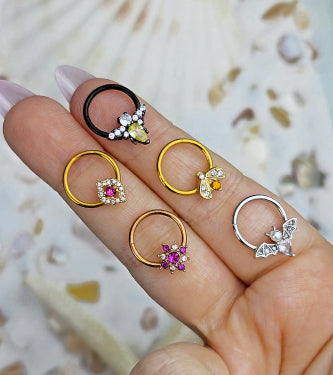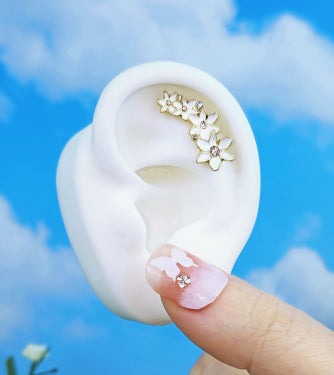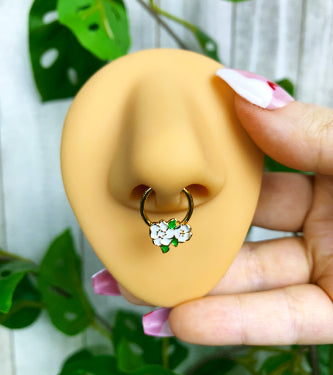Understanding Cubic Zirconia: CZ vs. Diamond
Diamond is an extremely special stone. They are renowned for both their brilliance and their durability as the hardest stone known to man. They have also become a symbol of eternal love, set as the beautiful centerpiece of many an engagement ring. While diamonds are certainly a precious gem, they also come with an incredible price tag.
Enter Cubic Zirconia (CZ) - first synthesized in 1976, it has since become the dominant alternative option for achieving that sparkling, diamond look. Since it is a man-made material, it is often flawless, giving it a similar curb appeal to diamond at a fraction of the price.
Body Candy is overflowing with CZ options in almost any color you can imagine. From belly button rings to nipple bars, we're here to educate you on all things Cubic Zirconia. Here's what you need to know about this fantastic stone!
CZ is Man Made
Although it sounds like a synonym for "fake," don't let the word synthetic rub you the wrong way. As a man-made stone, CZ is less of a "fake diamond" and more of a completely different material with similar aesthetic qualities.
Cubic Zirconia is synthesized in a lab, but that doesn't necessarily mean it's "fake." Structurally (and in very technical terms) Cubic Zirconia is considered "crystallographically isometric" - in other words, it has the most important attribute of a material that can simulate the look and feel of a diamond. Most importantly - Cubic Zirconia still has a high "refractive index," which means it will sparkle and shine similar to a diamond.
The best thing about CZ gems? They are just as sparkly as diamonds, come in a rainbow of colors, and are extremely affordable.
What are the Differences Between CZ and Diamond?
There are a few key factors that separate diamonds and CZ gems:
1.) Cost
Diamonds are rare. Depending on the size, cut, and clarity - they can cost anywhere from hundreds to thousands of dollars. As a man-made material, CZ gems are grown in a lab, making them plentiful and easily obtained - this means they can be inexpensive without sacrificing beauty. To put it into perspective, a one karat diamond could cost anywhere around $1500, whereas a one karat CZ gem would typically be less than $20.
2.) Hardness
Diamond is one of the hardest materials known to man, measuring a perfect 10 on the Moh's scale. CZ gems are also relatively hard at an 8.5. That slight difference in hardness makes CZ gems a bit more prone to scratching and cloudiness (especially because CZ gems have a tendency to absorb oils over time). This just means you might have to take a little extra care of your CZ gem to keep it looking brand new.
3.) Density/Weight
Cubic Zirconia is more dense than diamond (CZ rates a 5.5 - 5.9 as compared to diamond at 3.5 - 3.53). This means that any CZ gem is always going to weigh more than a diamond of the same size. In the case of body jewelry, since gems are relatively small, this difference will be almost imperceptible.
4.) Dispersion/Refractive Index
Both of these metrics explain the way that light passes through and then reflects off of a CZ gem or diamond respectively:
"Dispersion" measures what happens when light passes through a gemstone and is scattered (or dispersed), contributing to the gemstone's sparkly quality or "fire."
The "Refractive Index" measures the angle at which the light bends as it enters a gem, which contributes to the "brilliance" of the gem or stone.
Cubic Zirconia has a higher dispersion rating, which means it's more sparkly and reflective than a diamond. Diamonds, on the other hand, have a higher refractive index rating and capture more light, which means they are more "brilliant" than CZ gems.
To an untrained eye, it might be hard to spot any visual differences between a CZ gem and a genuine diamond. To put it simply, CZ gems are more sparkly, but may only show a few colors when reflecting. Diamonds are more likely to give off a fiercely captivating spectrum of colors when hit with light, but will sparkle less intensely.
5.) Flawlessness
Something especially unique about CZ gems - unless there is a problem with production, they are always flawless. Diamonds, on the other hand, typically have at least some sort of fleck, or "inclusion," inside the stone. Flawless diamonds are incredibly rare, which is reflected in their price point.
Typically, you'll need a magnifying glass or other type of visual aid to see these tiny inclusions - they are often too small to be seen by the naked eye. Utilizing the right tools, jewelers can tell by a gem's flawlessness whether the stone in question is a diamond or CZ.
CZ Gems in ALL of Your Piercings
Now that you're an expert in identifying the differences between CZ gems and diamonds, it's time to fill your mods with some fresh Body Candy!
While we don't recommend trying to pass off a CZ gem as a genuine diamond, DO recommend keeping body jewelry cool and affordable. We offer all kinds of CZ body jewelry for any modified individual looking for that sparkly, jeweled look. Try one out in a septum ring or a navel ring. Check out some more of the collections we have below.











